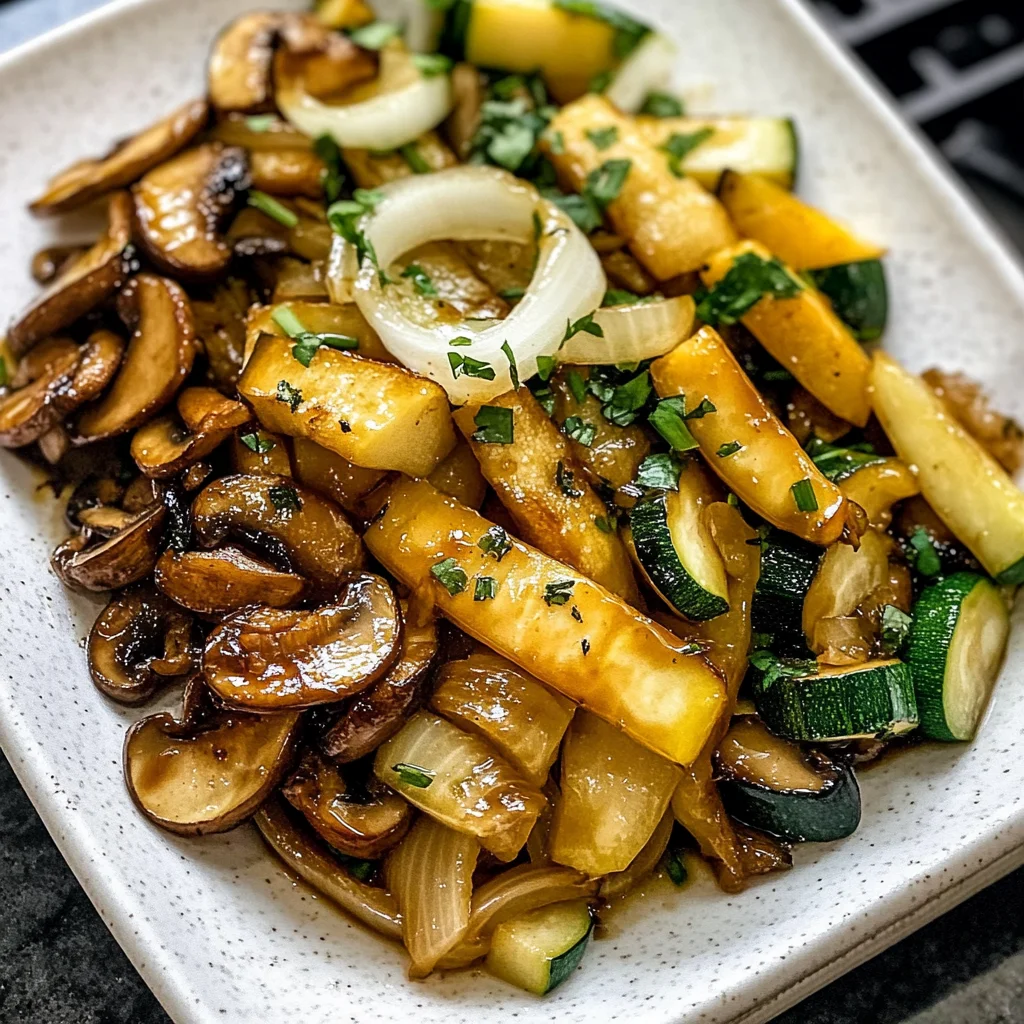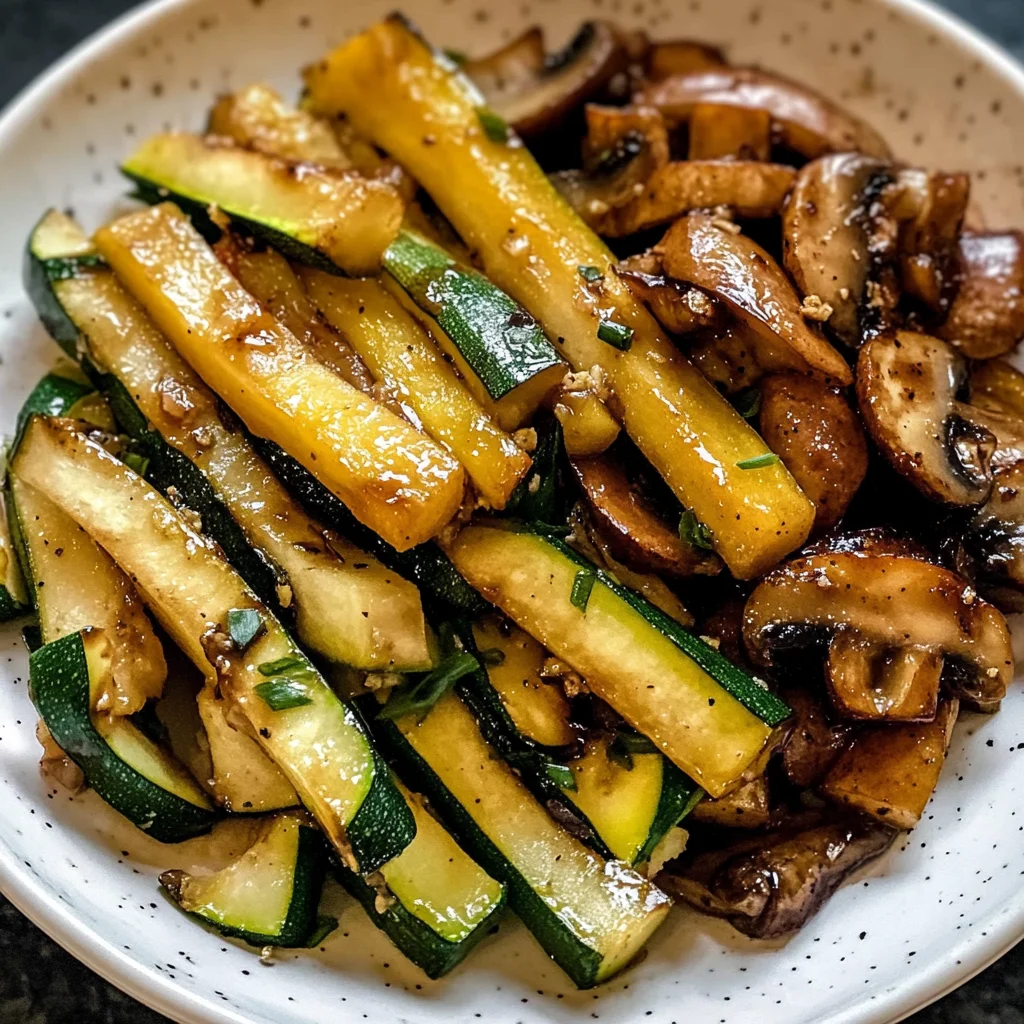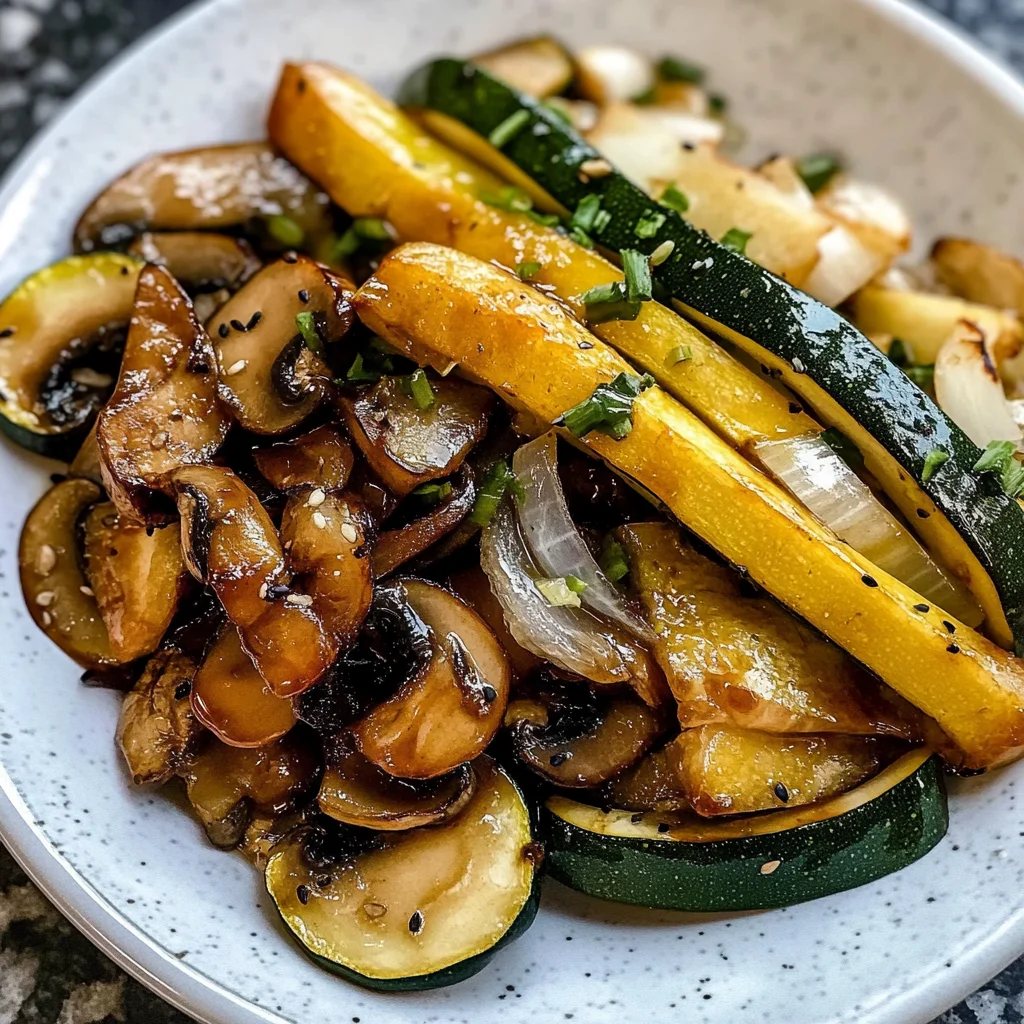Hibachi Vegetables are a delightful way to enjoy a colorful blend of fresh produce, bringing the flavors of Japan right to your kitchen. This easy recipe showcases vibrant yellow squash, zucchini, mushrooms, and onions, making it perfect for various occasions, from family dinners to casual gatherings. Enjoy the delicious taste and aroma of hibachi-style cooking without leaving home.

Jump to:
- Why You’ll Love This Recipe
- Tools and Preparation
- Essential Tools and Equipment
- Importance of Each Tool
- Ingredients
- For the Vegetables
- For Seasoning
- How to Make Hibachi Vegetables
- Step 1: Heat Your Pan
- Step 2: Sauté Onions
- Step 3: Add Zucchini and Squash
- Step 4: Season Your Vegetables
- Step 5: Serve Warm
- How to Serve Hibachi Vegetables
- Pair with Fried Rice
- Serve with Grilled Chicken or Beef
- Enjoy as a Salad Topping
- Create a Wrap
- Drizzle with Yum Yum Sauce
- How to Perfect Hibachi Vegetables
- Best Side Dishes for Hibachi Vegetables
- Common Mistakes to Avoid
- Storage & Reheating Instructions
- Refrigerator Storage
- Freezing Hibachi Vegetables
- Reheating Hibachi Vegetables
- Frequently Asked Questions
- What are Hibachi Vegetables?
- Can I customize my Hibachi Vegetables?
- How can I make Hibachi Vegetables vegan?
- What should I serve with Hibachi Vegetables?
- Final Thoughts
- 📖 Recipe Card
Why You’ll Love This Recipe
- Quick and Easy: This dish comes together in just 30 minutes, making it perfect for busy weeknights.
- Flavorful and Fresh: Utilizing fresh vegetables means maximum flavor and nutrition with every bite.
- Versatile Side Dish: Pair these hibachi vegetables with any main course or enjoy them on their own.
- Customizable Ingredients: Feel free to mix in your favorite veggies or adjust seasoning to suit your taste.
- Healthy Option: Packed with nutrients while being low in calories, this dish is a guilt-free addition to any meal.
Tools and Preparation
Having the right tools will make your cooking experience smoother and more enjoyable. Here are the essentials you’ll need for making Hibachi Vegetables.
Essential Tools and Equipment
- Wok or large skillet
- Spatula
- Cutting board
- Knife
Importance of Each Tool
- Wok or large skillet: Ideal for evenly cooking vegetables at high heat while allowing ample space for stirring.
- Spatula: A flexible tool that helps flip and stir ingredients without damaging them.
- Cutting board: Provides a safe surface to chop vegetables quickly and efficiently.
- Knife: A sharp knife makes cutting through vegetables quick and safe.

Ingredients
Hibachi Vegetables are made with fresh yellow squash, zucchini, mushrooms, and onions. It is the same Japanese style restaurant version in the comfort of your own home.
For the Vegetables
- 1 tablespoon butter
- 2 tablespoons vegetable oil or olive oil
- 1 cup onion, quartered and thinly sliced
- 2 cups zucchini, cut into strips
- 2 cups yellow squash, cut into strips
- 1 cup mushrooms, sliced
For Seasoning
- 2 teaspoons soy sauce
- 1/4 teaspoon salt
- 1/4 teaspoon ground black pepper
How to Make Hibachi Vegetables
Step 1: Heat Your Pan
Begin this easy recipe by heating the wok or large skillet over medium-high heat. Add the 1 tablespoon butter; once it melts, add in the 2 tablespoons oil.
Step 2: Sauté Onions
Add the 1 cup sliced onion to the pan. Sauté for about 2 minutes until they begin to soften and become translucent.
Step 3: Add Zucchini and Squash
Introduce the prepared 2 cups zucchini, 2 cups yellow squash, and 1 cup mushrooms into the pan. Stir well to combine all ingredients.
Step 4: Season Your Vegetables
Next, add in the 2 teaspoons soy sauce along with 1/4 teaspoon salt and 1/4 teaspoon ground black pepper. Continue stirring frequently until the vegetables soften to your preference—this should take about 10 minutes.
Step 5: Serve Warm
Serve these delicious hibachi vegetables warm alongside hibachi-style fried rice and yum yum sauce. Any leftovers can be stored in an airtight container in the refrigerator for up to 3 days.
How to Serve Hibachi Vegetables
Hibachi Vegetables are a versatile side dish that pairs well with many meals. Whether you’re enjoying a casual dinner or hosting a gathering, these colorful veggies will impress your guests.
Pair with Fried Rice
- Pairing with fried rice adds a hearty element to your meal and complements the flavors of the hibachi vegetables perfectly.
Serve with Grilled Chicken or Beef
- Grilled chicken or beef brings additional protein to your plate, making for a balanced and satisfying meal.
Enjoy as a Salad Topping
- Use hibachi vegetables as a fresh topping for salads. Their sautéed flavor adds depth and texture to greens.
Create a Wrap
- Wrap the hibachi vegetables in tortillas along with some protein for a delicious and healthy meal on-the-go.
Drizzle with Yum Yum Sauce
- Serve these vegetables drizzled with yum yum sauce for an extra kick of flavor that enhances the overall dish.
How to Perfect Hibachi Vegetables
To achieve the best version of Hibachi Vegetables, consider these helpful tips:
Use Fresh Ingredients: Fresh vegetables enhance flavor and texture. Choose vibrant produce for the best results.
Slice Evenly: Cut all vegetables into uniform sizes. This ensures even cooking and prevents some pieces from overcooking while others remain crunchy.
Don’t Overcrowd the Pan: Cook in batches if necessary. Overcrowding can lead to steaming instead of sautéing, which affects crispness.
Adjust Seasoning: Taste as you cook. Adjust salt or soy sauce according to your preference for seasoning.
Best Side Dishes for Hibachi Vegetables
Hibachi Vegetables make an excellent accompaniment to various dishes. Here are some great options:
- Fried Rice – A classic side that is full of flavor and complements hibachi vegetables beautifully.
- Grilled Chicken Skewers – Juicy chicken skewers add protein and balance out the meal.
- Teriyaki Tofu – For a plant-based option, teriyaki tofu provides sweetness and heartiness.
- Miso Soup – This warm soup adds depth to your dining experience and is light yet flavorful.
- Seaweed Salad – A refreshing salad that offers a contrast in texture and brings additional nutrients.
- Spring Rolls – Crispy spring rolls filled with fresh veggies provide crunch and color alongside hibachi vegetables.
- Steamed Broccoli – Simple yet nutritious, steamed broccoli pairs well without overpowering other flavors.
- Sushi Rolls – Add sushi rolls for an authentic Japanese dining experience that is fun and interactive.
Common Mistakes to Avoid
Cooking Hibachi Vegetables can be a delightful experience, but there are common pitfalls that can affect the final dish.
- Overcooking the vegetables: Cooking them for too long can make them mushy. Stir-fry just until they’re tender yet still crisp.
- Using the wrong oil: Not all oils are suitable for high heat. Choose vegetable or olive oil for better flavor and smoke point.
- Neglecting seasoning: Skipping soy sauce or salt can result in bland flavors. Always season properly to enhance taste.
- Cutting vegetables unevenly: Inconsistent sizes lead to uneven cooking. Cut your vegetables into similar sizes for even results.
- Crowding the pan: Adding too many vegetables at once can lower the temperature of the pan. Cook in batches if necessary.

Storage & Reheating Instructions
Refrigerator Storage
- Store leftovers in an airtight container.
- Refrigerate within two hours of cooking.
- Consume within 3 days for best quality.
Freezing Hibachi Vegetables
- Place cooled vegetables in freezer-safe containers or bags.
- Label with date and contents for future reference.
- Use within 2 months for optimal freshness.
Reheating Hibachi Vegetables
- Oven: Preheat to 350°F (175°C) and warm on a baking sheet for about 10-15 minutes.
- Microwave: Heat in short intervals, stirring in between, until heated through.
- Stovetop: Sauté in a skillet over medium heat until warmed, adding a splash of water if needed.
Frequently Asked Questions
Here are some commonly asked questions regarding Hibachi Vegetables.
What are Hibachi Vegetables?
Hibachi Vegetables are a blend of fresh vegetables stir-fried in traditional Japanese style, often served with rice and sauces.
Can I customize my Hibachi Vegetables?
Absolutely! Feel free to add or replace any vegetables you like, such as bell peppers or broccoli, to suit your taste.
How can I make Hibachi Vegetables vegan?
Simply use vegetable broth instead of chicken broth and ensure that your soy sauce is plant-based. All other ingredients are already vegan-friendly!
What should I serve with Hibachi Vegetables?
These vibrant veggies pair well with fried rice, grilled meats, or tofu dishes for a complete meal.
Final Thoughts
Hibachi Vegetables offer a delicious way to enjoy fresh produce with vibrant flavors. This recipe is versatile and easy to customize based on your preferences. Give it a try and savor the delightful taste of homemade hibachi!
Did You Enjoy Making This Recipe? Please rate this recipe with ⭐⭐⭐⭐⭐ or leave a comment.
📖 Recipe Card
Print
Hibachi Vegetables
- Total Time: 30 minutes
- Yield: Serves 4
Description
Experience the deliciousness of Hibachi Vegetables made at home! Quick, easy, and packed with flavor—try this recipe today!
Ingredients
- 1 tablespoon butter
- 2 tablespoons vegetable oil or olive oil
- 1 cup onion, quartered and thinly sliced
- 2 cups zucchini, cut into strips
- 2 cups yellow squash, cut into strips
- 1 cup mushrooms, sliced
- 2 teaspoons soy sauce
- 1/4 teaspoon salt
- 1/4 teaspoon ground black pepper
Instructions
- Heat a wok or large skillet over medium-high heat. Add butter; once melted, add the oil.
- Sauté the sliced onion for about 2 minutes until softened and translucent.
- Introduce zucchini, yellow squash, and mushrooms to the pan. Stir to combine.
- Season with soy sauce, salt, and pepper. Stir frequently until vegetables are tender but still crisp (about 10 minutes).
- Serve warm alongside your favorite main dishes.
- Prep Time: 10 minutes
- Cook Time: 20 minutes
- Category: Side Dish
- Method: Sautéing
- Cuisine: Japanese
Nutrition
- Serving Size: 1 cup (150g)
- Calories: 95
- Sugar: 3g
- Sodium: 270mg
- Fat: 5g
- Saturated Fat: 2g
- Unsaturated Fat: 3g
- Trans Fat: 0g
- Carbohydrates: 10g
- Fiber: 3g
- Protein: 2g
- Cholesterol: 5mg





